2016 PEUGEOT 3008 weight
[x] Cancel search: weightPage 5 of 344
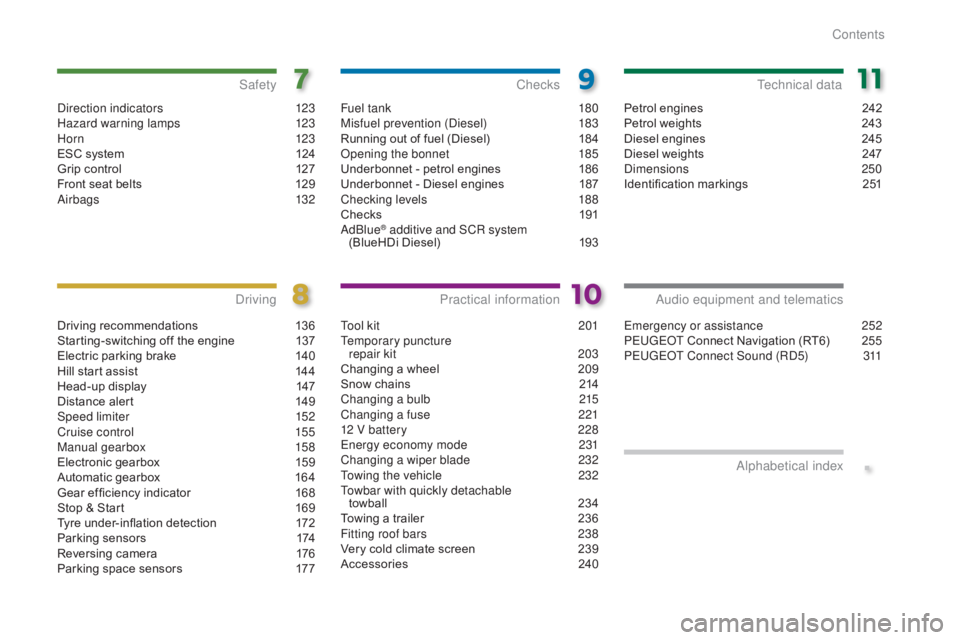
.
3008_en_Chap00a_sommaire_ed01-2015
Direction indicators 123
Hazard warning lamps 1 23
H or n
12
3
ESC system
1
24
Grip control
1
27
Front seat belts
1
29
Airbags
1
32
Safety
Driving recommendations 136
Starting-switching off the engine 1 37
Electric parking brake
1
40
Hill start assist
1
44
Head-up display
1
47
Distance alert
1
49
Speed limiter
1
52
Cruise control
1
55
Manual gearbox
1
58
Electronic gearbox
1
59
Automatic gearbox
1
64
Gear ef ficiency indicator
1
68
Stop & Start
1
69
Tyre under-inflation detection
1
72
Parking sensors
1
74
Reversing camera
1
76
Parking space sensors
1
77
Driving
Emergency or assistance 2 52
PE UGEOT C onnect Navigation (RT6) 2 55
P
E
UGEOT
C
onnect Sound (RD5)
3
11
Audio equipment and telematics
Alphabetical index
Fuel tank 1 80
Misfuel prevention (Diesel) 1 83
Running out of fuel (Diesel)
1
84
Opening the bonnet
1
85
Underbonnet - petrol engines
1
86
Underbonnet - Diesel engines
1
87
Checking levels
1
88
Checks
19
1
AdBlue
® additive and SCR system
(BlueHDi Diesel) 1 93
Checks
Tool kit 2 01
Temporary puncture repair kit
2
03
Changing a wheel
2
09
Snow chains
2
14
Changing a bulb
2
15
Changing a fuse
2
21
12 V battery
2
28
Energy economy mode
23
1
Changing a wiper blade
2
32
Towing the vehicle
2
32
Towbar with quickly detachable
towball
2
34
Towing a trailer
2
36
Fitting roof bars
2
38
Very cold climate screen
2
39
Accessories
2
40
Practical information
Petrol engines 2 42
Petrol weights 2 43
Diesel engines
2
45
Diesel weights
2
47
Dimensions
250
Identification markings
2
51
Technical data
Contents
Page 13 of 344
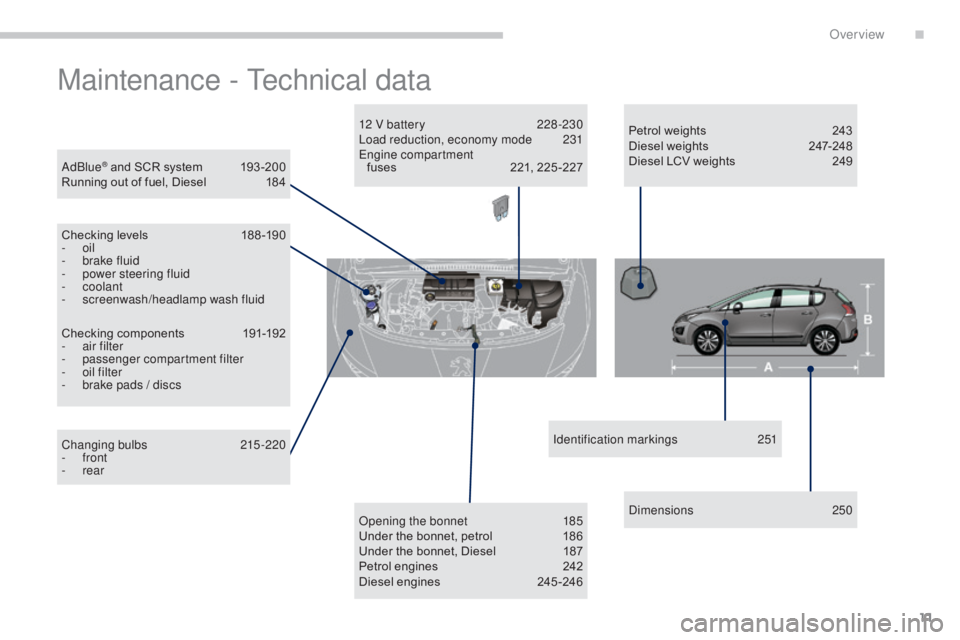
11
3008_en_Chap00b_vue-ensemble_ed01-2015
Maintenance - Technical data
AdBlue® and SCR system 193 -200
Running out of fuel, Diesel 1 84
Checking levels
1
88 -190
-
oil
-
b
rake fluid
-
p
ower steering fluid
-
coolant
-
s
creenwash/headlamp wash fluid
Changing bulbs
2
15-220
-
front
-
rear
Checking components
1
91-192
-
a
ir filter
-
p
assenger compartment filter
-
o
il filter
-
b
rake pads / discs Opening the bonnet
1
85
Under the bonnet, petrol
1
86
Under the bonnet, Diesel
1
87
Petrol engines
2
42
Diesel engines
2
45 -246Identification markings
2
51
Dimensions
2
50
12 V battery
2
28 -230
Load reduction, economy mode
23
1
Engine compartment fuses 2 21, 225 -227Petrol weights
2
43
Diesel weights
2
47-248
Diesel LCV weights 2 49
.
Over view
Page 60 of 344
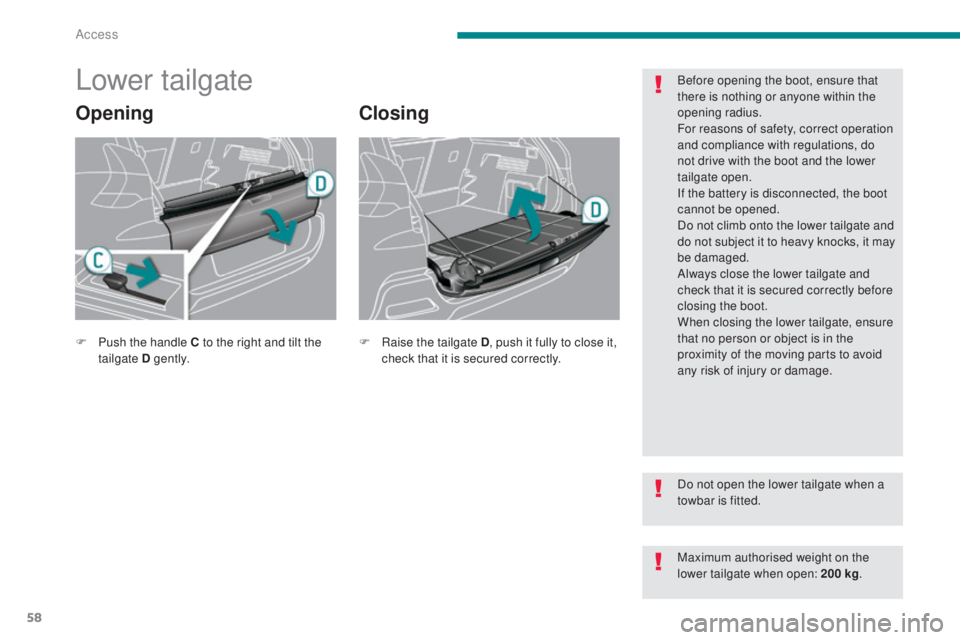
58
3008_en_Chap02_ouvertures_ed01-2015
Lower tailgate
OpeningClosing
Before opening the boot, ensure that
there is nothing or anyone within the
opening radius.
For reasons of safety, correct operation
and compliance with regulations, do
not drive with the boot and the lower
tailgate open.
If the battery is disconnected, the boot
cannot be opened.
Do not climb onto the lower tailgate and
do not subject it to heavy knocks, it may
be damaged.
Always close the lower tailgate and
check that it is secured correctly before
closing the boot.
When closing the lower tailgate, ensure
that no person or object is in the
proximity of the moving parts to avoid
any risk of injury or damage.
Do not open the lower tailgate when a
towbar is fitted.
Maximum authorised weight on the
lower tailgate when open: 200 kg .
F
P
ush the handle C to the right and tilt the
tailgate D g e nt l y. F
Ra
ise the tailgate D , push it fully to close it,
check that it is secured correctly.
Access
Page 73 of 344
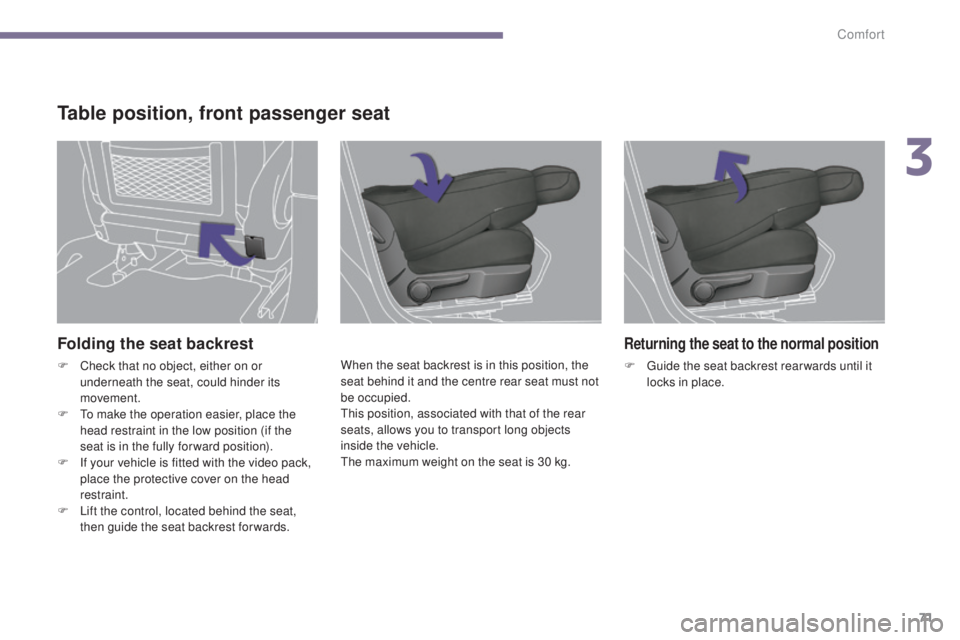
71
3008_en_Chap03_confort_ed01-2015
Folding the seat backrest
F Check that no object, either on or underneath the seat, could hinder its
movement.
F
T
o make the operation easier, place the
head restraint in the low position (if the
seat is in the fully for ward position).
F
I
f your vehicle is fitted with the video pack,
place the protective cover on the head
restraint.
F
L
ift the control, located behind the seat,
then guide the seat backrest for wards. When the seat backrest is in this position, the
seat behind it and the centre rear seat must not
be occupied.
This position, associated with that of the rear
seats, allows you to transport long objects
inside the vehicle.
The maximum weight on the seat is 30 kg.
Table position, front passenger seat
Returning the seat to the normal position
F Guide the seat backrest rear wards until it
locks in place.
3
Comfort
Page 111 of 344
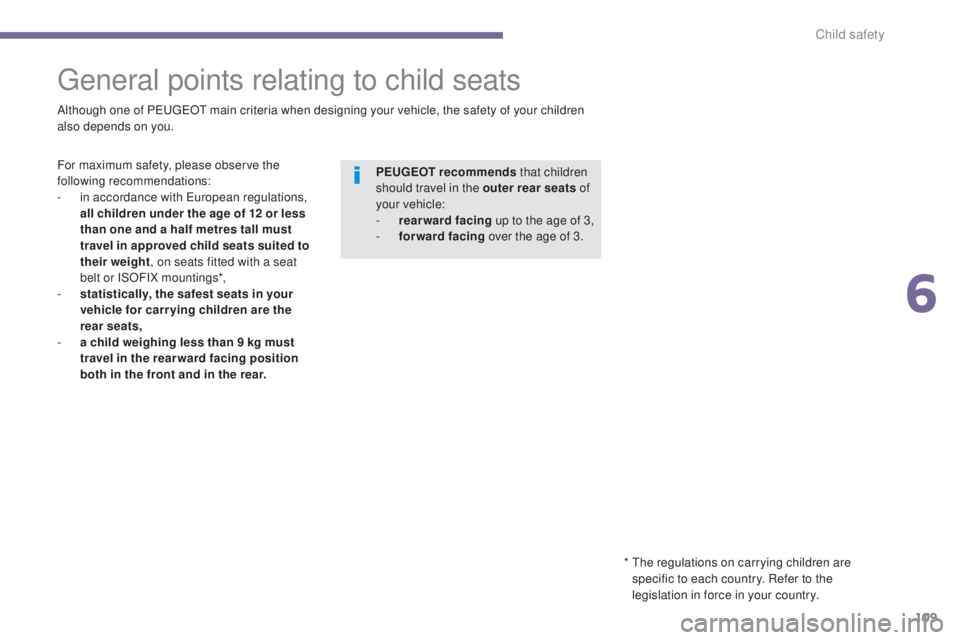
109
3008_en_Chap06_securite-enfants_ed01-2015
General points relating to child seats
Although one of PEUGEOT main criteria when designing your vehicle, the safety of your children
also depends on you.*
T
he regulations on carrying children are
specific to each country. Refer to the
legislation in force in your country.
For maximum safety, please observe the
following recommendations:
-
i
n accordance with European regulations,
all children under the age of 12 or less
than one and a half metres tall must
travel in approved child seats suited to
their weight , on seats fitted with a seat
belt or ISOFIX mountings*,
-
s
tatistically, the safest seats in your
vehicle for carr ying children are the
rear seats,
-
a c
hild weighing less than 9 kg must
travel in the rearward facing position
both in the front and in the rear. PEUGEOT recommends
that children
should travel in the outer rear seats of
your vehicle:
-
re
arward facing up to the age of 3,
-
fo
rward facing over the age of 3.
6
Child safety
Page 119 of 344

117
3008_en_Chap06_securite-enfants_ed01-2015
Installing child seats attached using the seat belt
a: universal child seat, child seat that can be installed in all vehicles using a seat belt.
b: group 0, from birth to 10 kg. Shell seats and baby carriers cannot be installed in the front passenger seat.
c: refer to the legislation in force in your country before installing your child on this seat.
U: seat suitable for the installation of a child seat secured using a seat belt and universally approved, rear ward facing and/or for ward facing.
U (R): as for U , with the vehicle's seat adjusted to the highest position and as far back as possible.
L-: only the child seats indicated can be installed on the seat concerned (depending on local legislation).
X: seat position not suitable for installation of a child seat for the weight class indicated.
In accordance with European regulations, this table indicates the options for installing child seats secured using a seat belt and universally approved
(a)
in accordance with the weight of the child and the seat in the vehicle.
* Child seats with a support leg should be fitted to your vehicle with care. See "Fitting a child seat with a support leg" for more information. Weight of the child and indicative age
Seat Under 13 kg
(groups 0 (b) a n d 0 +)
Up to approx 1 year From 9 to 18 kg
(g r o u p 1)
1 to 3 years approx From 15 to 25 kg
(group 2)
3 to 6 years approx From 22 to 36 kg
(group 3)
6 to 10 years approx
Front passenger seat (c)
with height adjuster U (R)
U (R)U (R)U (R)
Front passenger seat (c)
without height adjuster X
XXX
Outer rear seats U* U* U* U*
Centre rear seat L1L2L5, L6 L5, L6
6
Child safety
Page 122 of 344
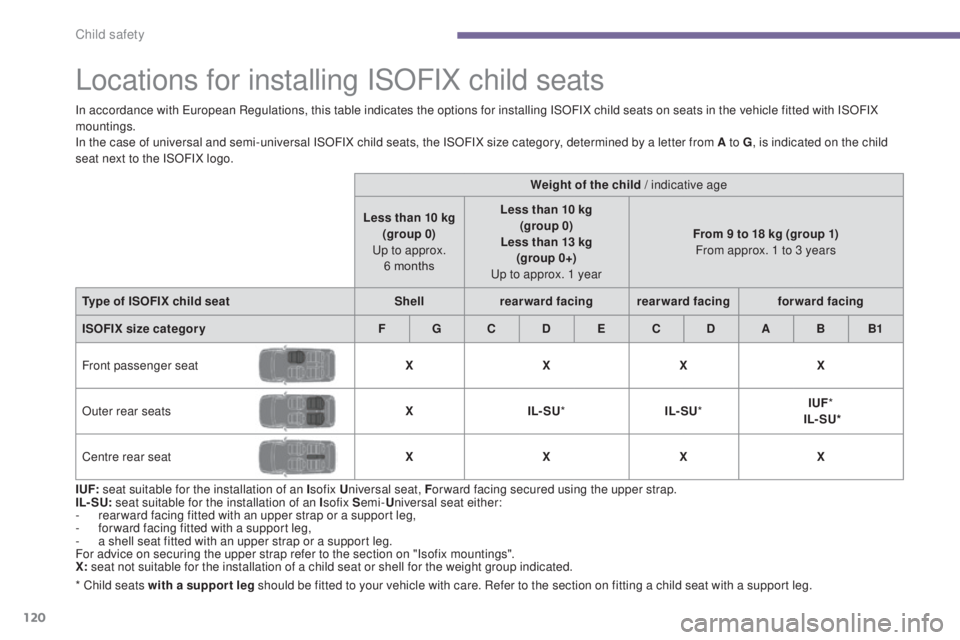
120
3008_en_Chap06_securite-enfants_ed01-2015
Locations for installing ISOFIX child seats
I UF: seat suitable for the installation of an I sofix Universal seat, F or ward facing secured using the upper strap.
IL- SU: seat suitable for the installation of an I sofix Semi-Universal seat either:
-
r
ear ward facing fitted with an upper strap or a support leg,
-
f
or ward facing fitted with a support leg,
-
a s
hell seat fitted with an upper strap or a support leg.
For advice on securing the upper strap refer to the section on "Isofix mountings".
X: seat not suitable for the installation of a child seat or shell for the weight group indicated.
In accordance with European Regulations, this table indicates the options for installing ISOFIX child seats on seats in the vehicle fitted with ISOFIX
mountings.
In the case of universal and semi-universal ISOFIX child seats, the ISOFIX size category, determined by a letter from A to G
, is indicated on the child
seat next to the ISOFIX logo.
* Child seats with a support leg should be fitted to your vehicle with care. Refer to the section on fitting a child seat with a support leg. Weight of the child / indicative age
Less than 10 kg (group 0)
Up to approx. 6 months Less than 10 kg
(group 0)
Less than 13 kg (group 0+)
Up to approx. 1 year From 9 to 18 kg (group 1)
From approx. 1 to 3 years
Type of ISOFIX child seat Shellrearward facing rearward facing forward facing
ISOFIX size categor y F G C D E C D A B B1
Front passenger seat XXXX
Outer rear seats XIL- SU* IL- SU* IUF
*
IL- SU*
Centre rear seat XXXX
Child safety
Page 235 of 344
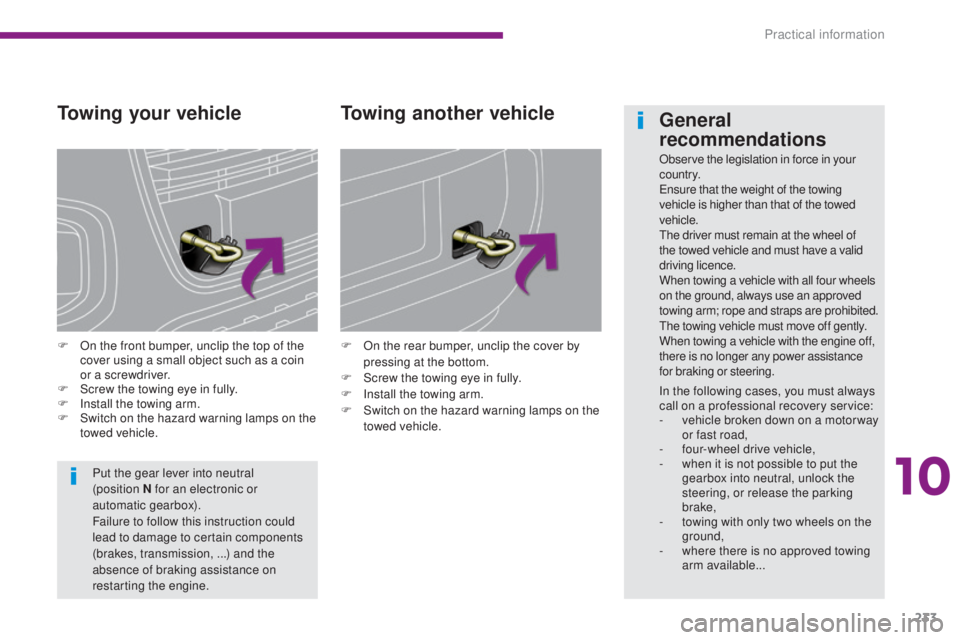
233
3008_en_Chap10_infos-pratiques_ed01-2015
Towing your vehicle
F On the front bumper, unclip the top of the cover using a small object such as a coin
or a screwdriver.
F
S
crew the towing eye in fully.
F
I
nstall the towing arm.
F
S
witch on the hazard warning lamps on the
towed vehicle. F
O n the rear bumper, unclip the cover by
pressing at the bottom.
F
S
crew the towing eye in fully.
F
I
nstall the towing arm.
F
S
witch on the hazard warning lamps on the
towed vehicle.
Towing another vehicle
Put the gear lever into neutral
(position N for an electronic or
automatic gearbox).
Failure to follow this instruction could
lead to damage to certain components
(brakes, transmission, ...) and the
absence of braking assistance on
restarting the engine.
General
recommendations
Observe the legislation in force in your
c o unt r y.
Ensure that the weight of the towing
vehicle is higher than that of the towed
vehicle.
The driver must remain at the wheel of
the towed vehicle and must have a valid
driving licence.
When towing a vehicle with all four wheels
on the ground, always use an approved
towing arm; rope and straps are prohibited.
The towing vehicle must move off gently.
When towing a vehicle with the engine off,
there is no longer any power assistance
for braking or steering.
In the following cases, you must always
call on a professional recovery service:
-
v
ehicle broken down on a motor way
or fast road,
-
f
our-wheel drive vehicle,
-
w
hen it is not possible to put the
gearbox into neutral, unlock the
steering, or release the parking
brake,
-
t
owing with only two wheels on the
ground,
-
w
here there is no approved towing
arm available...
10
Practical information